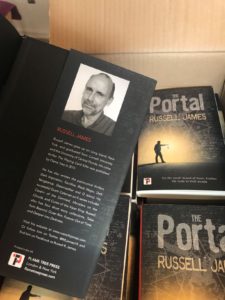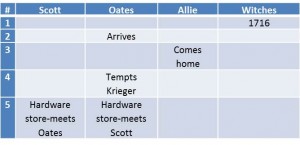The new novel LAMBS AMONG WOLVES has some real history behind it, but it’s not my first book to do so. Read about the details here.
Tag: russell james
LAMBS AMONG WOLVES was inspired by visits to a number of amazing places in Europe. You can check out some of them here.
THE PORTAL Arrives Soon!

Oct 20, 2020 is the the day THE PORTAL is published for all to enjoy. What was its rocky road to publication? Follow this link to The Story Behind The Story.
In Over Your Head
 There comes a point in every home improvement project where I look at the half-assembled collection of raw materials from Home Depot and say “What the hell have I gotten myself into?” I seriously question if I’ve exceeded my skill set. The project always takes longer than my initial estimate.
There comes a point in every home improvement project where I look at the half-assembled collection of raw materials from Home Depot and say “What the hell have I gotten myself into?” I seriously question if I’ve exceeded my skill set. The project always takes longer than my initial estimate.
Novel writing is no different. Stringing together one hundred thousand words with coherence is a daunting task. Then there’s character development, plot twists, pacing, setting, and through it all the nagging fear that on a shelf somewhere what you’re doing has been done before. After the initial, exuberant ten to twenty thousand words, that familiar self-doubt sneaks into the writing room. “What the hell have I gotten myself into?”
A lot of authors I talk to get this feeling, especially those who’ve done a lot of short stories. One beauty of a short story is its brevity. You can plot the three or four scenes the story needs in your head, lay them down on paper, and tweak to perfection. Like building a shed, you know that you’ve raised four solid walls and a roof and all you’re doing is arranging things within.
Not so with the novel. Now you’re building a house. Even with four finished walls, you’re sizing rooms, laying pipe, and running wiring until you type the last chapter. It’s easy to feel lost and overwhelmed.
Your best bet is to just keep plowing ahead. Don’t let the immensity of the project and the endless details, swamp you. Get that first draft finished. If you think of something that doesn’t quite fit with what you’ve written before, just leave a note in the margins to go back and fix it later. Completion gives you a sense of accomplishment and the assurance that you probably do have four walls and a roof. The story now has a beginning, a middle, and an end.
Now you can go back and work out the kinks. Some ways to do that:
- Look at the overall flow of the story, with two sentences that describe each chapter. See where plot lines intersect. If one story thread goes missing too long, rearrange chapters to keep the thread fresh in the reader’s mind. In a novel like BLACK MAGIC that covers about a week in time, I shifted Thursday events to Monday and they worked better.
- Follow one character at a time through the story. Only review the chapters where that character appears. Are that character’s dialogue and actions consistent? Does that character’s story arc progress plausibly? My novel Q ISLAND has multiple POVs. This method let me refine language for each person, give them consistent usage and common idioms.
- Near the end, scrub that prose. Read the story aloud to yourself, preferably alone so people don’t think you are insane. This method really unearths repetitive words and structures. It also highlights clunky sentences. If a sentence is hard to read aloud, it’s probably hard to read at all. My novella BLOOD RED ROSES frequently uses archaic sentence structures since it is set in 1864. Reading it aloud really helped tune the meter of those sentences within paragraphs to better evoke the time period.
A novel has multiple facets that make it a success. Fine tune your work from one perspective at a time. Like any DIY project, it will probably take more time than you originally estimated.
This is my 1968 Camaro convertible. I rescued her from outside Wichita. Her name is Dorothy because she isn’t in Kansas anymore. And yes, this post will eventually be about writing.
Now you may look at Dorothy as a candidate for the junkyard. And yes, she needs some work. Well, she needs almost everything. But she has nice options like a power top and a manual transmission. And most important, she has a good frame, the rails that support the car. I can put new fenders, a new top, and new floorboards on a good frame. Without a strong frame, the car would collapse on itself, no matter how many new parts I added.
Along with resurrecting a car, I’m resurrecting a manuscript. It’s not as old as Dorothy, but it’s from a while ago. I re-read the synopsis, remembered how enthusiastic I was writing it, and thought it had promise.
It became slow going. Apparently, I thought adverbs were wonderful back them. When writing monologues, seems I confused “internal” with “Interminable.” I’ve cut so many redundant passages that the 90,000 word novel is verging on novella. After four tedious hours where the story bored even me, I considered giving up and working on one of the new ideas always sitting in queue.
The time had come for the seat-of-the pants writer to turn outliner. This always happens to me, usually about two-thirds into the manuscript. I need to make sure the threads are all weaving into some coherent pattern. I went through each chapter and summarized the main action and what characters were involved. I like to put it in a table like the example below:
This way I can follow multiple, overlapping plotlines, like Chapter 5 where Scott and Oates meet.
After looking over the chart, I decided to stick with it. Like Dorothy, the story has a good frame, but here it’s called plot.
So why am I bored by it? Characters without fire, without connection, are killing it. I can fix that. In this action-driven paranormal thriller, that will be the equivalent of swapping out Dorothy’s fenders and recovering her seats. Plot problems, like a rust-weakened frame, requires so much re-writing, I’d rather just start something else that stirred new passion.
If a story isn’t feeling right, take the time to ensure the plot clicks. It is a lot easier for those of you who outline compared to pantsers like myself. By the way, this is an example of why my advice is don’t be a pantser. Way too time consuming, with lots of writing dead ends. I read an interview with a prolific author who said he used to be a pantser and had to switch methods to keep his volume up.
Back to work. Two projects to finish. Of the two, Dorothy might take a little longer.


